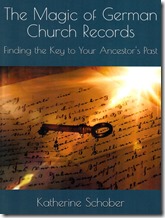 Title: The Magic of German Church Records: Finding the Key to Your Ancestor’s Past
Title: The Magic of German Church Records: Finding the Key to Your Ancestor’s Past
Author: Katherine Schober
Format: Paperback
Published: 2020
My Rating: ![]()
![]()
![]()
![]()
The following review first appeared in the Federation of Genealogical Societies FORUM magazine (Fall 2020); reprinted with permission.
This post contains affiliate links.
In The Magic of German Church Records, Katherine Schober provides a helpful process for deciphering German church records, along with other useful information. The book is written in an upbeat and cheerful tone, which lends to the encouragement of Schober that you can indeed use German church records in your research, even if you can’t read the language or the old script handwriting.
The book is organized into two parts. In the first part, you will learn about a variety of things that are useful for working with German church records, including where to find the records. I particularly liked chapter 4, which focuses on abbreviations and symbols. Chapter 6, the final chapter in part 1, discusses ten websites that can be helpful when working with German records; there were a few that were new to me, and I look forward to exploring them further.
The second part of the book is where the meat is. Here you will learn strategies for deciphering records of baptism, marriage, and death, both in the column and paragraph formats. There is also a chapter for deciphering family registers.
Schober takes you through a step-by-step process for deciphering each of the record types/formats and provides examples to illustrate each point. She shows you what information to extract, where it is typically found within the record, and how to locate and decipher it. At the end of each chapter you will see the complete transcription and translation. You will find a good deal of repetition throughout these chapters, but it is purposeful—when you pull out the book to refer to it later, you can go directly to the record type/format and get everything you need, without having to flip to and read other parts of the book.
In addition to an index, you’ll find six appendixes, one of which includes additional record samples with transcriptions and translations. Another appendix consists of 12 pages of words typically found in church records, with the German and English version, as well as what the word looks like in the old German handwriting. I also found the appendix on common occupations helpful.
Overall, this is a great reference book to use while you are working with German church records. Although you might be inclined to purchase the book and only refer to it as needed, I highly recommend that you read the entire book from cover to cover to familiarize yourself with all of the content and references. Then, keep it close at hand when you dig into those church records you’ve collected, but have been hesitant to tackle. This book will guide you through the process to uncover the gems contained in those records.


Share your thoughts...